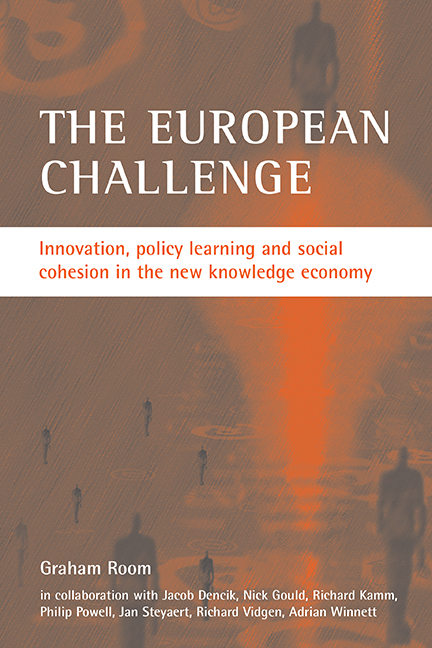Book contents
- Frontmatter
- Contents
- List of figures and tables
- Preface
- one The new knowledge-based economy
- two The EU response
- three Growth and stability
- four Dynamics and innovation
- five Enterprise and organisational change
- six Human investment and learning
- seven Social cohesion and inclusion
- eight Models and measurement
- nine Benchmarking and governance
- ten Globalisation and the knowledge economy
- Endnotes
- References
- Index
two - The EU response
Published online by Cambridge University Press: 18 January 2022
- Frontmatter
- Contents
- List of figures and tables
- Preface
- one The new knowledge-based economy
- two The EU response
- three Growth and stability
- four Dynamics and innovation
- five Enterprise and organisational change
- six Human investment and learning
- seven Social cohesion and inclusion
- eight Models and measurement
- nine Benchmarking and governance
- ten Globalisation and the knowledge economy
- Endnotes
- References
- Index
Summary
Introduction
The European Union has long been preoccupied with the fear of falling ever further behind the economies of the United States and east Asia. During the 1980s the main barrier to European economic development was seen as being the fragmentation of different national markets: the response was the drive to create a Single Market, a project which was in principle at least to be completed by 1992 (Cecchini, 1988). With a single home market, European enterprises would, it was hoped, be able to operate on a scale to match their American and Japanese rivals. During the 1990s economic and monetary union consolidated the project.
During the late 1990s the focus of attention shifted to the new information technologies and their associated economic transformations. The fear now was that the US would run away with the knowledge-based industries of the new economy, while east Asia – China in particular – would capture the manufacturing industries associated with the old economy. This would leave Europe with a bleak future. Moreover, the globalisation of the economy – the result in part of political initiatives, notably the rise of the WTO, and in part of the rapid communications and 24/7 working which the new technologies have enabled – meant that these challenges from North America and Asia would become more and more pressing. Europe had nowhere to hide. Even the notion that China would concentrate on the old economy, and leave the ‘triad’ of Europe, North America and Japan to divide out the new economy, began to look forlorn (Schaaper, 2004).
Recognising these dangers but also the opportunities, the Lisbon European Summit in March 2000 set a new strategic goal for the Union for the new decade: “to become the most competitive and dynamic knowledge-based economy in the world, capable of sustaining economic growth with more and better jobs and greater social cohesion” (Presidency Conclusions: European Council, 2000b, para 5). This not only asserted the ambition to play a central role in the development of the new knowledge-based industries: it also reaffirmed a long-standing goal of European political economy and – implicitly at least – a critique of the American: to temper the flexibility and insecurity of the market with high quality social protection and an active public policy.
- Type
- Chapter
- Information
- The European ChallengeInnovation, Policy Learning and Social Cohesion in the New Knowledge Economy, pp. 11 - 22Publisher: Bristol University PressPrint publication year: 2005



